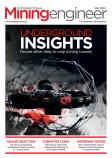Maurice Jones examines wear protection problems and solutions on chutes and feeders
Inadequate attention to the wear subject to rock abrasion and impact can be very costly, both in terms of inconvenient downtime as repairs are made or in the cost of replacement of parts that should have a much longer service life. This problem can be alleviated by the installation of lining material of appropriate composition, shape and fixing method to better cope with the assault by materials being handled.
Typical locations in mining for wear-resistant lining or liners include grizzlies and crusher feeds, bunkers and chutes, conveyor transfer points and discharges, dumper truck bodies, and loader and excavator buckets. Related applications are found in solids-carrying fluid-handling such as pumps, valves and pipes.
Lining materials can come in many forms selected on the basis of required abrasion and corrosion resistance, impact resistance, shape to be lined and cost. Common materials in addition to the basic mild steel of the structure include cast iron, abrasion resistance alloys, hard facing, rubber (natural and synthetic), urethane and ceramics.
Composites
Composite construction is also widespread; in particular rubber-backed ceramic tiles such as the Calyco range from Australian Mining Equipment Supplies. Other materials available from the company include ceramic mats and tiles, cast basalt, and Silicon Carbide.
The Weir Group (Minerals Division) recently acquired speciality rubber products specialist R Wales of North America. Its product range includes rubber linings for chutes and specialises in custom rubber and urethane moulded wear components.
ASGCo (offers its Armorite abrasion-resistant wear liners for hard-rock mining applications including line belts, feeders, grizzlies, chutes and bin impact areas. Consisting of a combination of high chromium and molybdenum white iron alloy, the modules are metallurgically bonded to a mild –steel backing to cushion the white iron and so resist impact. It can be welded after minimal preparation. Armorite Chocky conveyor wear bars are claimed to be an alternative to hard-facing welding methods. They are available in five sizes.
Urethane cast products can be custom-made within a confidentially agreement to protect commercial interests. The polyurethane components so made are said to be extremely abrasion resistant for bulk transport applications.
The installation of wear components may often be a highly skilled process necessitating qualified personnel aware of the wider implications. For example, the feeder manufacturer Jeffrey Rader Corp points out that their feeders are balanced for a certain weight and wear liners should be replaced with the same weight material as the original liners. Neither should new liners be installed on top of the remains of old ones. Bolt-on liners need to have the same pattern as the original liners
Video 1: Hopper feeder fitted with K-Superlube polyurethane lining system wear resistance and low-friction discharge
Video 2: Demonstration of the Davies WPS TaperLock fixing system for nickel hard wear plates with flush fittings





















